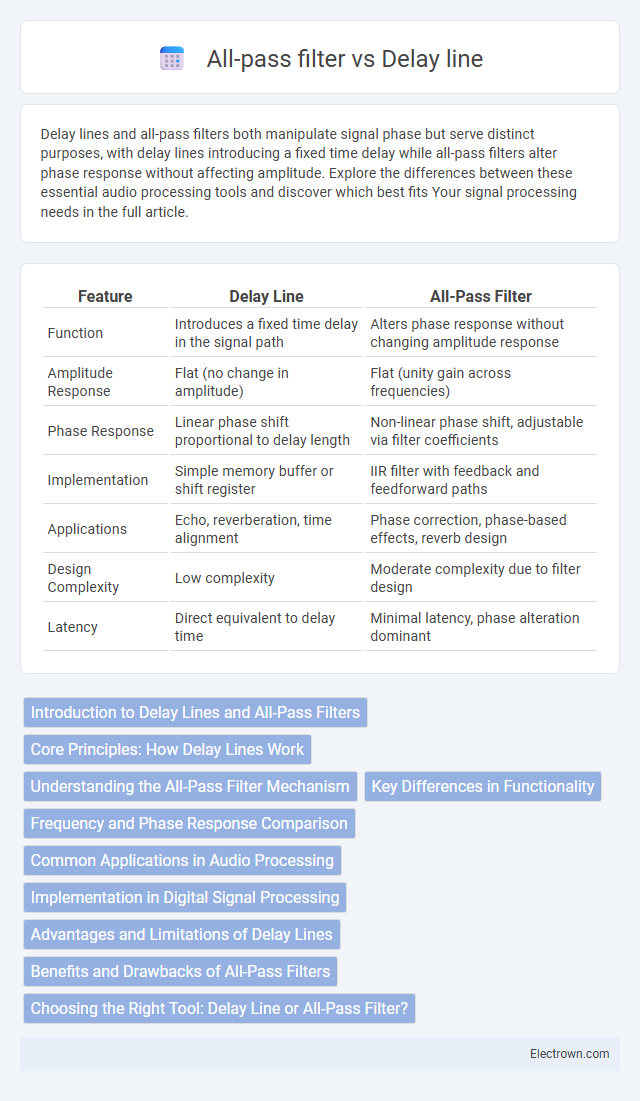Delay lines and all-pass filters both manipulate signal phase but serve distinct purposes, with delay lines introducing a fixed time delay while all-pass filters alter phase response without affecting amplitude. Explore the differences between these essential audio processing tools and discover which best fits Your signal processing needs in the full article.
Table of Comparison
| Feature | Delay Line | All-Pass Filter |
|---|---|---|
| Function | Introduces a fixed time delay in the signal path | Alters phase response without changing amplitude response |
| Amplitude Response | Flat (no change in amplitude) | Flat (unity gain across frequencies) |
| Phase Response | Linear phase shift proportional to delay length | Non-linear phase shift, adjustable via filter coefficients |
| Implementation | Simple memory buffer or shift register | IIR filter with feedback and feedforward paths |
| Applications | Echo, reverberation, time alignment | Phase correction, phase-based effects, reverb design |
| Design Complexity | Low complexity | Moderate complexity due to filter design |
| Latency | Direct equivalent to delay time | Minimal latency, phase alteration dominant |
Introduction to Delay Lines and All-Pass Filters
Delay lines store audio signals for a specific period before outputting them, creating time-based effects such as echoes and reverbs. All-pass filters modify the phase of input signals without changing their amplitude, maintaining the original sound's frequency spectrum while affecting its spatial characteristics. Understanding these fundamental components is crucial for designing advanced audio processing systems that enhance your sound's depth and texture.
Core Principles: How Delay Lines Work
Delay lines operate by storing an input signal for a specified period before outputting it, effectively shifting the signal in time while preserving its waveform and amplitude. They are essential in creating echo, reverb, and time-based effects in audio processing by replicating the input signal after a controlled delay. Unlike all-pass filters, which alter phase without affecting amplitude, delay lines maintain the original amplitude spectrum, making them fundamental for time-domain signal manipulation.
Understanding the All-Pass Filter Mechanism
The all-pass filter functions by maintaining constant amplitude across frequencies while altering phase response, creating a frequency-dependent delay effect. Unlike delay lines which produce discrete time shifts, all-pass filters implement continuous phase shifts, enabling precise control over signal timing and phase without affecting magnitude. This mechanism is crucial in applications like phase correction, phase modulation, and reverb design, where phase manipulation impacts sound perception without amplitude distortion.
Key Differences in Functionality
A delay line stores and outputs a signal after a fixed time interval, creating a distinct echo or time-shifted version of the input. An all-pass filter, in contrast, alters the phase response across frequencies without changing the amplitude, maintaining the signal's spectral content while affecting its temporal characteristics. Understanding these key differences helps you choose the right tool for applications like audio effects, with delay lines suited for echoes and all-pass filters for phase correction or reverb designs.
Frequency and Phase Response Comparison
Delay lines exhibit a linear phase response with uniform group delay across frequencies, resulting in constant time shifts without amplitude alteration. All-pass filters maintain a flat magnitude response but introduce frequency-dependent phase shifts, enabling phase manipulation without affecting signal amplitude. The frequency response of delay lines is characterized by comb filtering effects, while all-pass filters allow precise phase adjustment essential in phase equalization and signal alignment applications.
Common Applications in Audio Processing
Delay lines are commonly used in audio processing for creating echo, reverb, and slapback effects by storing and replaying audio signals after a specific time interval. All-pass filters excel in phase manipulation without affecting amplitude, making them ideal for phase correction, flanging, and enhancing spatial effects in audio mixes. Your choice between these tools depends on whether you need precise time-based delay or subtle phase alterations in your sound design.
Implementation in Digital Signal Processing
In digital signal processing, delay lines are implemented as arrays or buffers that store past signal samples, enabling precise time shifts critical for effects like echoes and reverberation. All-pass filters utilize recursive structures combining feedforward and feedback paths to alter the phase response without changing the amplitude spectrum, commonly achieved with one-pole or multi-pole difference equations. While delay lines offer straightforward sample delay manipulation, all-pass filters provide phase modification with minimal computational cost, useful in phase equalization and dispersion simulations.
Advantages and Limitations of Delay Lines
Delay lines offer precise time-based signal manipulation with low computational complexity, making them ideal for applications like echo generation and digital reverberation. Their advantages include simple implementation and exact delay control, while limitations involve potential signal degradation at longer delays and limited frequency response shaping compared to all-pass filters. Your choice depends on whether precise delay replication or phase alteration without amplitude change is more critical in your audio processing needs.
Benefits and Drawbacks of All-Pass Filters
All-pass filters provide precise phase shifting without affecting amplitude, making them ideal for applications requiring phase correction or delay equalization. Their design can introduce complexity and processing latency, which may impact real-time audio or signal processing tasks. Understanding these benefits and drawbacks helps optimize Your system's performance when phase manipulation is critical.
Choosing the Right Tool: Delay Line or All-Pass Filter?
Selecting between a delay line and an all-pass filter depends on desired audio effects and signal processing requirements. Delay lines introduce time-shifted replicas of the input signal, essential for echo and reverb creation, while all-pass filters maintain amplitude across frequencies but adjust phase, useful for phase alignment and phase-based effects. Understanding application goals such as time-based effects or phase correction guides the choice, optimizing signal integrity and achieving precise sonic characteristics.
Delay line vs all-pass filter Infographic

 electrown.com
electrown.com